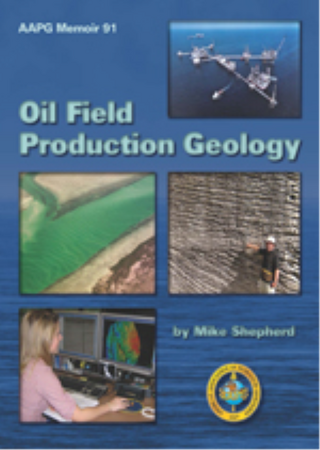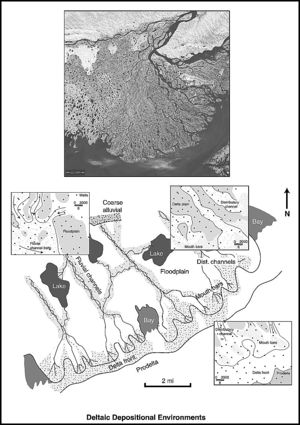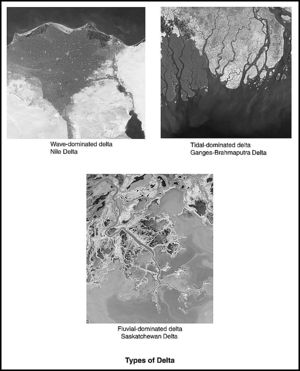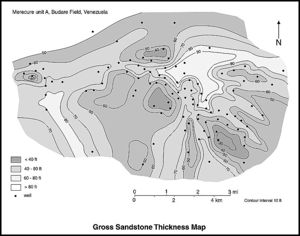Deltaic reservoirs
THIS PAGE IS UNDER CONSTRUCTION
| Oil Field Production Geology | |

| |
| Series | Memoirs |
|---|---|
| Part | The Production Geologist and the Reservoir |
| Chapter | Deltaic reservoirs |
| Author | Mike Shepherd |
| Link | Web page |
| PDF file (requires access) | |
| Store | AAPG Store |

Deltas are major sites of sand and mud deposition. They contain significant volumes of hydrocarbons worldwide (Figure 1). Major petroleum provinces include the Niger Delta in west Africa, the Mahakam Delta in Borneo, the Caspian Sea, and the Maracaibo Basin in Venezuela.
Deltaic sediments often form complex reservoirs
Delta systems make heterogeneous reservoirs, typically with a jigsaw-puzzle to labyrinthine sediment geometry (Table 1). There may also be considerable structural complexity. Many rivers, particularly the larger ones, dump very large quantities of sediment into deltas on top of an unstable substrate containing mobile salt and/or shale. Salt deformation features and growth faulting are common in deltaic sediments, and these can result in numerous segmented reservoirs, such as in the Tertiary Niger Delta in west Africa.[2][3]
| Characteristic | Favorable for reservoir development | Unfavorable for reservoir development |
|---|---|---|
| Growth faults common | - | Numerous sealing fault compartments |
| Shingled geometry | - | Results in bypassed oil in individual shingles |
| Increasing marine reworking of delta front | Creates increasing lateral connectivity in the delta-front sediments | - |
| Wave-dominated delta | More continuous, may have an aquifer | - |
| Fluvial-dominated delta | - | Can show low recoveries caused by labyrinthine geometry |
| Tidal-dominated delta | - | Low recoveries caused by complex geometry and numerous mud and silt baffles |
| Distributary channels form narrow sand bodies | - | May be missed by wells in fields with a large well spacing; difficult to locate injection wells |
| Distributary channel sands commonly the highest permeability facies association in deltas | Can be the most productive intervals in a delta | - |
| Stacked distributary channels | Larger sand bodies with good vertical connectivity and sweep | - |
| Mouth bars contain extensive mudstone laminae | - | Mouth bars may have poor vertical connectivity and sweep |
| Stacked mouth bars | Larger sand bodies with good vertical connectivity and sweep | - |
| Mouth bars separated vertically by shales | Individual mouth bars can be targeted by horizontal wells; shale prevents water influx from swept units above and below | Poor to no vertical connectivity between mouth bars |
| Coarser grained distributary channels cutting finer-grained delta-front sandstones | - | Can result in preferential water ingress into the delta-front area, bypassing oil in the delta-front sediments |
| Peripheral strand-plain complexes with high frequency marine shales | - | Poor vertical sweep with potential for bypassed oil |
Deltas are often gas reservoirs
Many deltaic reservoirs, particularly long-lived Tertiary to present-day delta areas, contain more gas than oil. This is because they can be particularly rich in coals and woody kerogen, which form gas-prone humic source material. Gas fields are found in the Mackenzie, Nile, and Irrawady deltas, for instance. Deltas can contain oil or mixed oil and gas where sandstones interfinger with a marine source rock.[4]


Types of delta
Deltas have been categorized into three classes in terms of sedimentary process: wave dominated, tidal dominated, and fluvial dominated (Figure 2).[6] Coarse-grained deltas include fan deltas and braid deltas. Each specific environment has its own geometries and typical reservoir characteristics. The geometrical patterns shown by the various types of delta can often be recognized on isochore, net-sand, and log-facies maps.[7] For example, a wave-dominated delta will show a T motif on these maps as a result of fluvial lineaments converging at a high angle to a shoreline trend (see Figure 3). The lobate shape of the delta front may also be recognized.
Depositional environments
The influence of river, wave, and tide on deltaic sediments produces a complex mix of macroforms. Fluvial processes dominate in the upper delta plain, although this area can also be swampy with marshes and lakes present. The lower delta plain is subjected to marine influence, acting to modify the fluvial-derived sediments. Delta fronts comprise nested complexes of distributary channels, mouth bars, tidal bars, and reworked delta-front sediments (Figure 1).
Distributary channels
Distributary channels are so called because of the way in which they branch off from the main feeder river and distribute water and sediment across the delta. Where the distributary channels split off from the main feeder river, the volume of water carried by individual channels will be a fraction of that in the main river. By comparison to fluvial channels, distributary channels tend to be narrower and shallower. Gibling[8] noted that distributary channels show a common width range of 10–300 m (33–984 ft) (see Table 2). Distributary channels tend to be straight where they incise a mud substrate and more sinuous within a sand substrate.[9]
| Depositional environment | Thickness | Width | Width/thickness ratio |
|---|---|---|---|
| Braided and low sinuousity rivers | 1-1200 m (3-3937 ft); most < 60 m (197 ft); common range 5-60 m (16-197 ft) | 50 m-1300+ km (164 ft-808+ mi); many > 1 km (0.62 mi); common range 0.5-10 km (0.3-6 mi) | 15-15,000+; some > 1000; common range 50-1000 |
| Meandering rivers | 1-38 m (3-125 ft); common range 4-20 m (13-65 ft) | 30 m-15 km (98 ft-9 mi); most < 3 km (1.8 mi); common range 0.3-3 km (0.1-1.8 mi) | 7-940; most < 250; many < 100; common range 30-250 |
| Delta distributaries | 1-35 m (3-115 ft); most < 20 m (65 ft); common range 3-20 m (10-65 ft) | 3 m-1 km (10 ft-0.6 mi); most < 500 m (1640 ft); common range 10-300 m (33-984 ft) | 2-245; most < 50; many < 15; common range 5-30 |
| Channels in eolian settings | 1-19 m (3-62 ft) | 2.5-1500 m (8.2-4921 ft); most < 150 m (492 ft) | 1-90; most < 15 |
| Valley fills on bedrock unconformities | 12-1400 m (39-4593 ft); most < 500 m (1640 ft) | 75 m-52 km (246 ft-32 mi); most < 10 km (6 mi) | 2-870; highly variable; mainly 2-100 |
| Valley fills within alluvial and marine strata | 2-210 m (6-689 ft); most < 60 m (197 ft) | 0.1-105 km (0.06-65 mi); common range 0.2-25 km (0.1-15 mi) | 4.6-3640; highly variable; common range 10-1000; many from 100 to 1000 |
| 1From Gibling[8], Journal of Sedimentary Research. Reprinted with permission from, and © by, the SEPM (Society for Sedimentary Geologists). | |||
Sand is deposited within linear distributary channels as side bars. In the modern-day Mahakam Delta, Borneo, side bars alternate on both sides of the distributary channels. These form elliptical sand pods, 5–8 km (3–5 mi) or more long and up to 1 km (0.6 mi) wide.[10] Channel fills typically show an upward-fining sediment profile and an upward-decreasing permeability profile. From the base upward, a distributary channel comprises the active channel fill, showing decimeter-scale trough cross-bedded sets; a partial abandonment fill with mainly centimeter-scale cross-beds; and sometimes an abandonment channel fill of thinly interbedded fine sand, silt, and shale.
See also
- Eolian reservoirs
- Meandering fluvial reservoirs
- Braided fluvial reservoirs
- Siliciclastic shorelines and barrier island reservoirs
- Deep-water marine reservoirs
- Carbonate reservoirs
References
- ↑ Tye, R. S., J. P. Bhattacharya, J. A. Lorsong, S. T. Sindelar, D. G. Knock, D. D. Puls, and R. A. Levinson, 1999, Geology and stratigraphy of fluvio-deltaic deposits in the Ivishak Formation: Applications for development of Prudhoe Bay field, Alaska: AAPG Bulletin, v. 83, no. 10, p. 1588–1623.
- ↑ Evamy, B. D., J. Haremboure, P. Kamerling, W. A. Knaap, F. A. Molloy, and P. H. Rowlands, 1978, Hydrocarbon habitat of Tertiary Niger Delta: AAPG Bulletin, v. 62, no. 1, p. 1–39.
- ↑ Tuttle, M. L. W., R. R. Charpentier, and M. E. Brownfield, 1999, The Niger Delta petroleum system: Niger Delta Province, Nigeria, Cameroon, and Equatorial Guinea, Africa: U.S. Geological Survey Open File Report 99-501, 210 p.
- ↑ Galloway, W. E., and D. K. Hobday, 1996, Terrigenous clastic depositional systems: Applications to petroleum, coal, and uranium exploration: New York, Springer-Verlag, 489 p.
- ↑ Hamilton, D. S., et al., 2002, Reactivation of mature oil fields through advanced reservoir characterization: A case history of the Budare field, Venezuela: AAPG Bulletin, v. 86, no. 7, p. 1237–1262.
- ↑ Galloway, W. E., 1975, Process framework for describing the morphologic and stratigraphic evolution of deltaic depositional systems, in M. L. Broussard, ed., Deltas, models for exploration: Houston Geological Society, p. 87–98.
- ↑ Coleman, J. M., and L. D. Wright, 1975, Modern river deltas: Variability of processes and sand bodies, in M. L. Broussard, ed., Deltas, models for exploration: Houston Geological Society, p. 99–149.
- ↑ 8.0 8.1 Gibling, M. R. 2006, Width and thickness of fluvial channel bodies and valley fills in the geological record: A literature compilation and classification: Journal of Sedimentary Research, v. 76, p. 731–770.
- ↑ Sneider, R. M., C. N. Tinker, and L. D. Meckel, 1978, Deltaic environment reservoir types and their characteristics: Journal of Petroleum Technology, v. 30, no. 11, p. 1538–1546.
- ↑ Allen, G. P., and J. L. C. Chambers, 1998, Sedimentation in the modern and Miocene Mahakam delta: Indonesian Petroleum Association, 236 p.